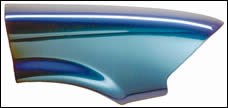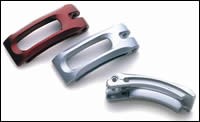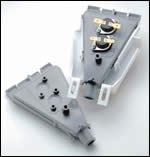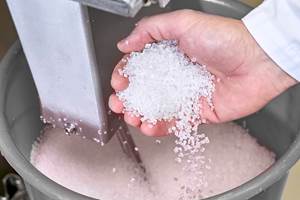NPE News Wrap-Up: Materials
New materials at NPE 2003 target automotive, appliance, and packaging sectors. Engineering thermoplasticsdominate the news, but there were also severalnew TPEs and a few polypropylene introductions.
Processors who came to NPE 2003 looking for new tools to replace traditional materials discovered a broad array of products for automotive, consumer, and packaging markets. Engineering thermoplastics far outnumbered commodity resins, and automotive materials were probably the most prominent of the new entries.
Continuing interest in replacing exterior auto body panels was fed by new thermoplastics from DuPont and Bayer intended to replace steel or thermosets. These new offerings may be described as multifunctional—combining structural properties, Class A decorative quality, and heat resistance to survive on-line painting and anti-corrosion E-coating at up to 400 F (205 C).
Still another thrust is toward elimination of paint through in-mold decorating with preformed inserts. GE Plastics pushed this approach by using its weatherable Lexan SLX film (previously called Sollx polymer) as the decorative appliqué or insert for exterior panels.
In a different metal-replacement thrust, BASF announced a nylon compound for automotive seat frames, potentially a 160-million-lb/yr market in North America.
For packaging, Basell North America launched metallocene PP grades for injection molded CD/DVD cases. Also, a number of new PET, PC, and EVOH offerings surfaced for blow molders, the new PETs being primarily aimed at improved performance in heat-set containers.
Meanwhile, a cluster of new TPEs are pushing the limits of softness, clarity, tactile feel, and overmolded adhesion strength.
Body panels revisited
DuPont unveiled reinforced PETs that tackle previous limitations of this material. Rynite PETs have typically been reinforced with 10% to 55% glass, which diminishes surface quality of auto exterior parts as well as molded-in-color appliance and electronics panels. Also, limited heat resistance has excluded PET use in exterior panels to be E-coated on-line with steel.
DuPont’s response is Shine-E Rynite PET compounds that deliver super gloss levels (60° ratings of 90 to 100), Class A surface quality, and an ability to survive E-coating at 205 C. The new family utilizes a modified polymer structure, more heat-resistant modifiers, and proprietary reinforcements in place of glass. These compounds reportedly paint like metals and can replace both steel and thermoset SMC in car fenders and other exterior parts. On-line paintable Shine-E Rynite 8001 has a flexural modulus of 500,000 psi, elongation 35%, and low moisture take-up. Compared with nylon/PPO like GE’s Noryl GTX, it is said to be both stiffer and more ductile in impact testing.
For unpainted parts, new Shine-E Rynite 8000 is a super-glossy grade that boasts excellent color stability and 640,000 psi flex modulus. Targets are parts subject to elevated temperatures: oven door handles, toaster oven parts, and motor housings as well as automotive shrouds and panels near the exhaust.
DuPont also unveiled platable and paintable Delrin acetals and high-temperature Zytel HTN nylons. Delrin Coatings Solutions is a package of platable and paintable compounds, etching solutions to activate part surfaces, and matched coatings. The aim is to replace shiny metal or plated ABS in window and door fixtures, ski-boot bindings and buckles, speaker grilles, and plumbing fixtures. In perfume bottle caps, one-piece plated acetal can cut costs by replacing a two-piece plated ABS closure.
Platable high-temperature nylons from DuPont come in high-stiffness and high-toughness versions that beat ABS for heat resistance and are said to be usable as “drop-in” substitutes in existing ABS plating equipment. Examples are appliance knobs and trim and auto under-hood parts and wheel covers.
Bayer’s answer to what it foresees as a 350% increase in demand for E-coatable thermoplastic exterior body panels is a developmental ABS/nylon 6 alloy, Triax DP3155. It is said to be stiffer than PPO/nylon but has an equivalent coefficient of thermal expansion. Bayer also launched a conductive version, TP3161, which eliminates the conductive priming step in on-line painting of fenders and rear side panels.
GE’s Lexan SLX was first available only as coextruded films for insert molding into weatherable auto and appliance parts. GE has now launched the first injection moldable grade. Lexan SLX 2431 exhibits 83% light transmission, only 1% haze, and 10-fold higher gloss than standard uv-stabilized PC. It could replace acrylic or other materials in light covers, refractors, and lenses. Lexan SLX is described as a polycarbonate copolymerized to anchor weatherability into the polymer backbone.
GE also showed off new Noryl GTX PPO/nylons that incorporate low-cost conductive carbon blacks for on-line electrostatic painting. Side mirror housings are one target application.
Engineering TPs galore
The recent acquisition of Honeywell’s nylons business broadens BASF’s line of nylon 6 and 66 compounds for consumer and electronic goods. An example is Capron SE glass-reinforced nylon 6 grades optimized for gas-assist molding. Designed for structural parts with good surface appearance, they are modified to handle the slower fill speeds and melt-front hesitation typical in gas-assist molding. Capron SE is said to provide a resin-rich surface for auto door handles, door bezels, mirror housings, steering wheels, and roof racks.
BASF’s automotive interiors team is putting top priority on auto seat pans as a large opportunity for reinforced nylons. Seat pans are currently made of steel with up to 50 springs, fasteners, and other components. They are heavy, costly, and complex to assemble. BASF’s Capron TG7F is a 34%-glass compound (acquired from Honeywell) that is impact-modified and heat-stabilized to control stiffness and toughness over a broad temperature range. It meets crash requirements and exhibits better recovery than steel. TG7F has been adopted for third-row seats in 2003-model SUVs from General Motors. In this application, nylon consolidates a dozen or more parts into a one-piece molding with about 50% weight savings. It also integrates snap-fit, self-locking devices and trim attachment features.
Ems-Grivory introduced two glass-reinforced nylon 6 grades with enhanced adhesion when overmolded with an SEBS or PP-based TPE. Grilon BG-25 HM is a 25%-glass product with flexural modulus of 1 million psi, and BG-40 HM is a 40%-glass version with 1.4-million psi modulus.
This supplier also expanded its high-temperature nylon line by adding black and natural versions using glass/mineral combinations in place of glass or mineral reinforcements alone. The 40% and 65% reinforced Grivory HT grades reduce warpage, improve surface appearance, and exhibit more isotropic thermal expansion.
New nylon 6 and 66 alloys from Ems-Grivory are said to offer high weld-line strength and excellent surface finish in mirror and appliance housings.
Asahi Kasei (AK) of Japan, the world’s second largest supplier of modified PPE (after GE), has some new Xyron grades. One reduces weight and cost and boosts chemical resistance in auto battery parts. AK also offers alloys of PPE and PPS for auto chassis components, disc-player housings and office-machine parts. They are said to provide excellent moldability and warp resistance.
AK’s acetal slate now includes an ultra-low-friction, lubricated Tenac grade for telecommunication equipment and a conductive version for fuel-pump modules. And its new line of acetal copolymers boasts improved mechanical properties for moving parts of fax machines, printers, and CD/DVD players.
Higher-flow versions of AK’s Leona nylon 66 line were also introduced at the show: Tenac 90G grades offer high stiffness, accept up to 60% reinforcement levels, and are processable at temperatures as low as 194 F. The 33%, 55%, and 60% glass-reinforced products are aimed at roof racks, wind deflectors, door handles, and auto side-mirror parts.
Bayer introduced a new class of polycarbonate copolymer offering higher heat resistance and elevated impact strength over a broad temperature range. These properties result from toughening through incorporating a novel comonomer rather than an elastomer. Makrolon DP1-1848 copolycarbonate has 50 kJ/m2 in notched Charpy impact strength together with 156 C (313 F) Vicat softening temperature plus high chemical and hot-water resistance. It is aimed at ski buckles, poles, and goggles as well as face shields, security glazing, and lighting.
Asahi Kasei introduced a novel class of polycarbonate made in Taiwan that use a new melt-polymerization process that is said to leave lower residuals in the resin that can cause mold deposits. These PCs are said to excel in optical discs.
LNP Engineering Plastics introduced Konduit Ultem, a thermally conductive compound based on GE’s polyetherimide resin.
Mitsui Chemicals described at the show a developmental crystalline version of its normally amorphous Aurum melt-processable polyimide. New Super-Aurum has an HDT of 400 C (752 F), which surpasses that of standard Aurum (240 C) and PEEK (330 C). Super-Aurum is offered in neat, reinforced, and lubricated versions. It requires no post-cure. It is designed to replace metal in moving parts and extreme environments. DuPont, the exclusive North American distributor of Aurum, will market the product in resin and rod forms.
Advances for packaging
New polypropylenes from Basell include a family of four Adstif PPs for packaging. They are produced with Basell’s Spheripol process for use in sheet extrusion, thermoforming, and cast film. (Earlier Adstif grades were made with the Catalloy process and were used as blending resins for injection molding auto parts). Their broad molecular-weight distribution reportedly gives the new Adstif grades a wide processing window and an enhanced balance of impact and stiffness beyond that of standard PP. Their clarity and stiffness combination is comparable to PS, PET, and PVC, according to Basell. For example Adstif X83-1, a 3.5 MFR homopolymer reportedly makes deli containers, drink cups, and lids with better clarity and impact strength than PS—plus lighter weight.
Basell also unveiled new Metocene metallocene PPs for packaging that are said to have improved clarity and lower extractable levels. Grade X50182, an 18 MFR grade for injection stretch-blow molding, vies with PET and HDPE for hot-fill bottles for flavored water, sports drinks, juices, and apple sauce. Grades X70293 (40 MFR) and X50109 (60 MFR) are for injection molded medical labware, optical-disc cases, housewares, cups, and containers. These grades boast good dimensional stability and autoclavability.
New problem-solving grades of PET also bowed in. Heat-set PET containers for packaging juices, fortified waters, sauces, and other hot-filled and pasteurized foods are growing at 15%/yr, but could grow even faster if PET heat-set bottles were not prone to degrade, discolor, or collapse. Also, vitamin fortification of hot-filled foods has prompted calls for improved uv resistance to protect the sensitive ingredients.
DAK Americas’ new HS (Heat Set) versions of its Laser+ PET resins tackle these issues. They are formulated for a higher glass-transition temperature to counter thermal degradation and yellowing. Their crystallinity is also controlled to reduce hazing and enhance stiffness and sidewall strength, making it feasible to lightweight heat-set bottles. In addition, their improved processability reportedly shortens cycle times and cuts energy use by 15%.
Korea’s SK Chemicals America has stepped up efforts to market its Skygreen PETG materials in the U.S. It offers grade S2008 for film and blow molding and K20112 for sheet extrusion. SK is said to be the only supplier other than Eastman’s Voridian Div. to make PETG based on CHDM as the glycol modifier. CHDM is said to confer exceptional clarity, toughness, and processability while retaining the heat resistance of straight PET.
Skypet BR, a modified PET copolyester from SK Chemicals, is designed to replace PC in 5-gal water jugs. Copolymerization slows crystallization in the bottle sidewalls to maintain clarity and increase toughness. Another new PET from the company is Skypet XL, tailored for faster heat absorption in preform ovens of reheat stretch-blow machines. Shorter cycles are said to result.
For barrier packaging Eval Co. of America (Evalca) rolled out 7 Series EVOH resins that boast 50% improved heat stability. They are likely to eventually replace existing grades. Initial grades in the 7 Series are F171, H171, and G176 with 32%, 38%, and 48% ethylene content, respectively. Developmental grades L171 and E171 (28% and 44% ethylene) will be launched shortly. This series is said to offer from fewer gels and less die-lip buildup than current versions. They are also said to improve adhesion in multi-layer cast and blown films.
Honeywell Specialty Polymers (HSP) is a new unit of Honeywell Corp.’s nylons group that was set up after the parent divested much of its nylons business to BASF. HSP markets barrier nylon and other polymers and has adopted the Aegis trade name for all its products. Beer bottles are one of the commercial uses reported for Aegis OX, HFX, and CSD high-barrier nylons, which are various combinations of nylon 6, nanoclay barrier filler, and a proprietary Honeywell oxygen scavenger. More recently, HSP has thrown R&D efforts into adapting Aegis nylons for industrial uses that require a barrier against hydrocarbon emissions—notably jerry cans and fuel tanks for power tools, lawn mowers, and boats.
TPEs seize new ground
Kraton Polymers introduced two novel styrene-butadiene copolymer (SBC) classes. Kraton A offers higher stiffness levels than conventional SEBS, as well as increased formulation freedom and adhesion to overmolded engineering thermoplastics (see story on p. 47). In contrast, two novel variants of conventional Kraton G SEBS offer lower stiffness than existing SEBS but improved clarity and flow. RP6924 and RP6917 grades are aimed at PP compounding such as clear tubing.
A year ago, Kraiburg TPE opened its first U.S. production facility for making SEBS and SEPS resins and compounds, underscoring its commitment to the North American market for soft-touch TPEs for consumer and auto-interior applications. Recent innovations include softer (10 Shore A) and higher-clarity versions of its Thermolast K SEBS.
At NPE, Kraiburg displayed an intriguing prototype auto inner door-panel module consisting of a PP-based substrate overmolded with a specially formulated SEBS. The SEBS skin provides soft touch, color stability, chemical resistance, and strong adhesion to the PP without a tie layer. The panel is a candidate for replacing PP/TPO and ABS/PVC systems requiring foam to achieve a soft surface. Kraiburg is pursuing the idea with Tier One interior systems suppliers who are searching for cost reductions and easy recycling. Commercialization is set for 2006.
GLS Corp.’s NPE introductions reflect a strategy of alloying TPEs to achieve new balances of properties. Versalloy 8000 TPV alloys (developed with DSM Thermoplastic Elastomers) include 60 and 70 Shore A grades (a 50 A is on the way) that reportedly offer superior moldability in complex tools and long flow paths. The products are said to “drop into” existing tools for PVC and SBC and are aimed at power tools and lawn/garden and leisure goods.
Together with BASF, GLS has developed what is claimed to be the softest TPU available. Versollan RU2203 has 45 Shore A hardness and the rubbery feel of a TPU but with 20% faster set-up in the mold than straight TPU. Designed mainly for grips, it offers good oil resistance, improved adhesion to engineering resins, and a dull matte finish.
Related Content
General Polymers Thermoplastics to Further Expand Distribution Business
NPE2024: Following the company’s recent partnership buyout, new North American geographic territories are in its sight.
Read MoreTracing the History of Polymeric Materials, Part 26: High-Performance Thermoplastics
The majority of the polymers that today we rely on for outstanding performance — such as polysulfone, polyethersulfone, polyphenylsulfone and PPS — were introduced in the period between 1965 and 1985. Here’s how they entered your toolbox of engineering of materials.
Read MorePrices Up for All Volume Resins
First quarter was ending up with upward pricing, primarily due to higher feedstock costs and not supply/demand fundamentals.
Read MorePrices Bottom Out for Volume Resins?
Flat-to-down trajectory underway for fourth quarter for commodity resins.
Read MoreRead Next
Making the Circular Economy a Reality
Driven by brand owner demands and new worldwide legislation, the entire supply chain is working toward the shift to circularity, with some evidence the circular economy has already begun.
Read MoreSee Recyclers Close the Loop on Trade Show Production Scrap at NPE2024
A collaboration between show organizer PLASTICS, recycler CPR and size reduction experts WEIMA and Conair recovered and recycled all production scrap at NPE2024.
Read MoreFor PLASTICS' CEO Seaholm, NPE to Shine Light on Sustainability Successes
With advocacy, communication and sustainability as three main pillars, Seaholm leads a trade association to NPE that ‘is more active today than we have ever been.’
Read More



























